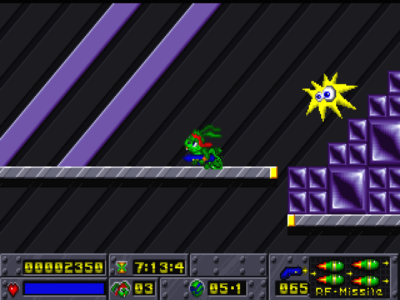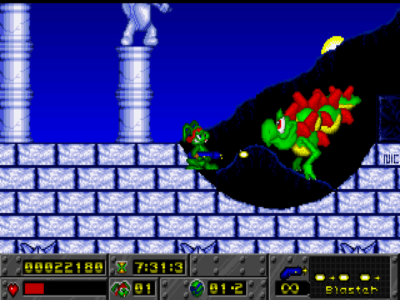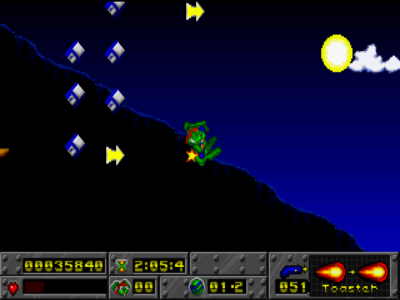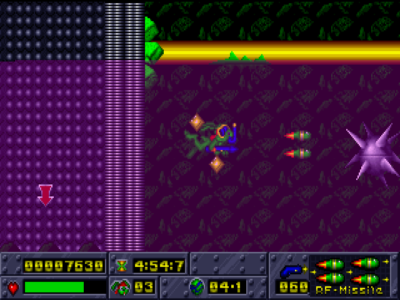
Jazz Jackrabbit
Written by: Rik
Date posted: January 27, 2020
- Genre: Action
- Developed by: Epic Megagames
- Published by: Epic Megagames
- Year released: 1994
- Our score: 6
Platform games aren’t a big favourite of mine. At the risk of sounding like a dreadful snob, they seemed ubiquitous during the 8-bit and 16-bit eras, with TV and movie licenses, in particular, converted into dreary platformers almost by default. Although there’s an argument, especially taking into consideration technical and practical limitations, for making many action films into platform-based shooters, it was usually at the exclusion of doing something more interesting, although alternative versions would often appear on different formats and occasionally one might try something more original or faithful to the source material. They also seemed to sum up the outside world’s view of games; that they were all about running, jumping and shooting – silly distractions designed for kids.
An entirely unfair set of generalisations, I’m sure. In any case, the PC wasn’t the natural home of such things, with a handful of home-grown favourites, such as Commander Keen or Bio Menace, lurking among a mass of half-hearted and inferior ports of Atari ST or Amiga games during the late 80s and early 90s. As the PC grew in stature as a gaming machine, though, the ambitions of arcade titles developed exclusively for DOS became bolder, taking aim at console favourites such as Street Fighter 2 and Super Mario Kart. Whether these games were actually as good as their TV-based rivals didn’t really matter (although it’d take a brave DOS nerd to approach the cool console kids in the playground and make such a claim) as the main target market mainly consisted of people who were denied access to a console in the first place and wouldn’t be in a position to make a detailed comparison.
Deep down, we all knew the truth of one thing: these PC games, charming and playable as they may be, were emphatically Not Cool. And this particular example is no exception: to begin on a rather childish note, even the name conjures up feelings of mild embarrassment, with the first part of our eponymous hero’s name provoking teenage memories of the phrase ‘jazz mags’, a British colloquialism for hard copy pornography, and the second calling to mind a possible brand name for a marital aid (*sigh* – yes, before you say it, I *would* know all about that kind of thing, wouldn’t I, ha ha etc). I’m not sure exactly why a green rabbit isn’t cool and a blue hedgehog (or a small Italian plumber) is, but that’s just the way it is.
That blue hedgehog is the most immediately obvious inspiration for Jazz Jackrabbit, with the latter, like Sonic, able to build up speed while running and use this to jump higher or longer as needed. However, as Jazz cannot kill enemies by jumping on them (all contact results in a loss of health), running through a level at high speed isn’t really advisable. Instead, our hero comes armed with a weapon, which can be upgraded, via in-level pickups, from the basic Blaster (with infinite ammo) to the Toaster or RF Missile (like the Blaster but with a wider blast radius) or the Bouncer, which is most useful for attacking enemies from above. The rarely-found TNT bombs, meanwhile, clear the whole area of enemies.
There is a story, of sorts, based around the kidnap of a princess, Eva Earlong, by an evil tortoise called Devan Shell. As Jazz, you are tasked with rescuing Eva, but first you must find her, which means searching various planets filled with platforms and things that can kill you. The game is split into six episodes, with the opener originally available as shareware (for those that remember such things) and the remainder upon registration. The version currently commercially available also includes additional bonus levels, including the two festive-themed Holiday Hare episodes.
For the purposes of this review, I only played the original six (by the end of which I must admit to having had my fill of what the game had to offer). Each episode consists of three worlds, and each world of two levels, and while there’s plenty of variety in terms of artwork, and occasionally in level design, it has to be said that the different worlds do tend to blend into each other after a while, and at various points I found myself restoring the wrong save and playing through a level I’d already completed.
Speaking of which, you can save at any point, but upon re-loading you’ll find yourself at the start of the level, with your original 3 lives, no advanced weapons and a score of 0, regardless of what state you were in before. There’s also a fairly generous system of continues which will let you reset the game to the same state upon loss of all lives. However, there are also mid-level checkpoints, to which you can return as long as you have at least one life left.
It’s a forgiving structure for anyone focused on getting through the game, as opposed to achieving a high score, and indeed, the very existence of a scoring system here seemed a little bit odd to me: there are scoring pickups and also an end-of-level tally of items collected and enemies killed, but the only way a score is registered by the game is if you allow yourself to die and skip the continue option when it appears. Equally, I wasn’t tempted to fiddle with the difficulty options, which determine how many hits Jazz can take before dying, and alter the countdown timer on each level to potentially add more of a time pressure to proceedings. I suppose as there’s actually no requirement to play the episodes in order (all are unlocked from the start), some may choose to play in a non-linear fashion and/or aim to achieve a high score with no continues, but it didn’t strike me as that kind of game.
Anyway, for a plodder like me, the default medium difficulty seemed fair enough most of the time, and I made steady progress, save for a couple of the very trickiest levels, one of which (I later discovered) is generally acknowledged to be virtually impossible due to one particular jump, and the other merely a tedious pain in the arse on account of it being found towards the very end of the game. Macho hardcore gamers will be disappointed to learn that I eventually decided to bypass these stages by unlocking the hoverboard using a cheat code, thereby preventing these relatively minor design issues from derailing my enjoyment of the rest of the game, rather than spending countless hours beating my fist on the keyboard and grinding my teeth into a fine powder before abandoning it all in a fit of pique due to my failings as a gamer and human being.
Said hoverboard is one of a number of supplementary non-weapon-based items available throughout the game, and allows you to cruise through a level and bypass any tricky jumps. Others include speed bonuses, shields and invulnerability, and a bird companion who flies above your head and assists you in combat. Oh, and you can regenerate health by picking up carrots (of course). On each planet there’s also a large gem to be found, which unlocks a bonus 3D mini-game (a bit like the Special Stages in Sonic 2) that involves collecting gems on a road-based maze to a time limit, successful completion of which gives you a reward of an extra life.
Each episode ultimately ends with a boss fight, usually against a machine-assisted turtle. Although some initially appear incredibly tough, they can be conquered fairly easily once you happen upon the correct strategy, such as standing in one particular place where you can’t take damage and firing repeatedly, although others are vanquished with slightly more complex and familiar tactics: observing movement patterns closely and taking opportunities to dodge and attack at the right time.
I was in the mood for a platform game, and for this one in particular, prior to playing, and I broadly enjoyed the experience, although it’s easier to pick out flaws and annoyances rather than elements that are worthy of particular praise. There’s a general problem with enemies coming at you rather quickly from off screen, and in some cases being able to attack you from this position without any fear of reciprocation (your bullets die as they hit the edge of the playing area, unlike those of some enemies). At other times, when you run away and come back again, you’ll find that baddies will immediately have reset to their initial starting position on the screen, rather than continuing on the path they were on, which can also be a bit confusing. In addition, apart from the sameyness of the levels (already noted above), the artwork of some has the effect (whether by accident or design) of camouflaging enemies, which also seems a little bit cheap at times.
You’d also say that Jazz isn’t the most charismatic of lead characters, belonging firmly in ‘cheery DOS knock-off’ territory, and in some stills his dozy appearance gives a suggestion that he was so-named due to a fondness for jazz cigarettes. There are a few ropey cut-scenes at various points, which don’t add very much either, although in truth these elements aren’t really integral to the enjoyment of this type of arcade caper.
I was once pulled up by a correspondent for the admittedly slightly lazy use of the phrase, “I’d certainly recommend it to anyone who likes this kind of thing” in a review, although his observation that almost anything else other than the game in question would be preferable to those people was qualified by the fact that these alternative options were not native to the PC, which is of course all we can really deal with here. But in the spirit of not repeating the same mistake, I should say that my immediate appetite for platforming action was entirely sated by the end of Jazz Jackrabbit, and I’m unlikely to check out contemporary titles either on PC or on console for comparison any time soon.
And so, I kind of enjoyed it without necessarily knowing how it rates against the very best platformers, which in a weird way sort of takes me back to 1994: harbouring a suspicion that the reasonably-presented DOS game in front of me probably wasn’t as good as the contemporary console favourites, but also being generally fine with not really knowing the difference. As excitable PC reviews might have put it at the time, “who needs Sonic when you’ve got Jazz?!?!” Which isn’t *quite* the same as saying that it’s as good, or better.






 Posts
Posts
Considering your review, “Jazz Rabbit must die” as Space Bunnies were also supposed to. 🙂 I’ve tried a few platformers back from Apple ][ days, never feeling the need to go beyond the 2 or 3 first levels. On PC, while not being a platformer player (FPS and flight sims), I nonetheless rather enjoyed, unexpectedly, the following titles : Claw, Pandemonium, Duke Nukem Manhattan Project and Trine (which was too easy but has a very pleasant atmosphere, possibly because of its very nice soundtrack — I don’t know about following Trine episodes).
January 28, 2020 @ 10:44 pm